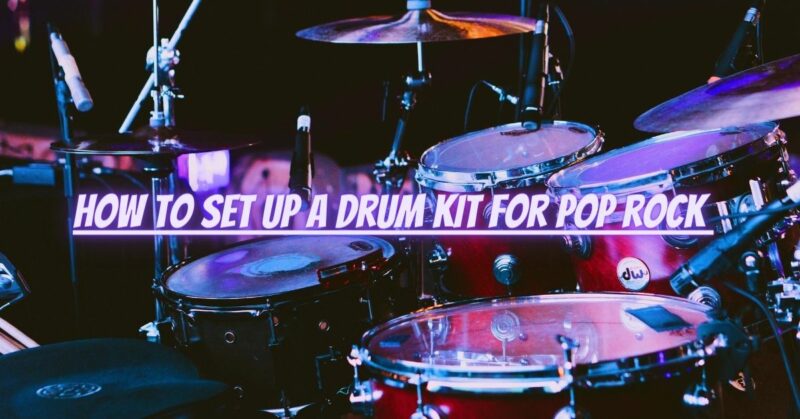Pop rock is a genre known for its catchy melodies, energetic rhythms, and vibrant sound. As a drummer in a pop rock band, your drum kit plays a vital role in shaping the overall feel and impact of the music. In this article, we will guide you through the process of setting up your drum kit for pop rock. From drum sizes and materials to cymbal choices and drumhead selection, we’ll explore the key elements to consider when configuring your kit to achieve the perfect sound for the pop rock genre.
- Drum Sizes and Materials: Pop rock music requires a balanced and versatile drum sound that blends well with various instruments. Opt for drum sizes that offer a moderate volume and projection. Consider a bass drum around 20 to 22 inches for a balanced low-end thump. Choose rack toms between 10 and 12 inches and a floor tom between 14 and 16 inches for a balanced range of tones. Drum shells made from versatile woods like maple or birch are commonly used in pop rock, as they provide a warm tone with a good balance of attack and sustain.
- Snare Drum Selection: The snare drum is the centerpiece of your drum kit in pop rock music, providing the backbeat and driving the rhythm. Look for a snare drum that offers versatility, sensitivity, and a wide tuning range. Consider a medium-sized snare drum, around 5.5 to 6.5 inches in depth, for a balanced and dynamic sound. Choose a snare drum that provides a crisp attack and good sensitivity to capture the nuances of pop rock drumming. Experiment with different snare drum materials, such as wood or metal, to find the desired tone that complements the genre.
- Cymbal Choices: Cymbals play a crucial role in creating the shimmering and dynamic sound of pop rock. Aim for a well-balanced cymbal setup that offers clarity, brightness, and musicality. Choose a ride cymbal that provides a clear and defined stick definition, with a balanced mix of ping and wash. Opt for crash cymbals that deliver a bright and explosive sound, capable of punctuating the energetic moments in pop rock songs. Hi-hats should have a crisp and articulate sound, allowing for precise and dynamic footwork. Experiment with different cymbal sizes and weights to find the right combination that suits your playing style and complements the pop rock sound.
- Drumhead Selection: Selecting the right drumheads is crucial for achieving the desired sound in pop rock drumming. Choose drumheads that offer durability, attack, and controlled sustain. Clear drumheads on the toms provide brightness and focused tones, allowing your drums to cut through the mix with clarity. Consider coated drumheads on the snare drum for a warm and controlled sound, ideal for capturing the essence of pop rock drumming. For the bass drum, choose a drumhead that offers a balance of punch and low-end presence, providing a solid foundation for the rhythm section.
- Ergonomics and Playability: Setting up your drum kit ergonomically is essential for comfort and optimal playing performance. Adjust the drum and cymbal heights, angles, and positions to suit your playing style and physical requirements. Use quality hardware and accessories that offer stability, durability, and ease of adjustment, allowing you to focus on your performance without distractions. Ensure that your drum kit setup allows for easy access to all the drums and cymbals, enabling you to play fluidly and expressively.
- Electronic Elements: Pop rock often incorporates electronic elements, such as samples, loops, or electronic drum triggers. Consider integrating electronic components into your drum kit setup to add texture and versatility to your sound. Explore the use of trigger pads, electronic drum modules, or hybrid drum kits that combine acoustic and electronic elements. Experiment with different electronic sounds and effects to create unique and modern pop rock sounds.
Conclusion: Setting up your drum kit for pop rock involves careful consideration of drum sizes, materials, cymbal choices, drumhead selection, ergonomics, and the integration of electronic elements. By choosing drum sizes that offer balance and versatility, selecting a versatile and responsive snare drum, experimenting with cymbals that provide clarity and brightness, using drumheads that offer attack and control, configuring your kit ergonomically, and exploring electronic elements, you can create an instrument that captures the energy and vibe of pop rock music. Remember to listen to pop rock recordings, study the drumming styles of influential drummers, and practice with a focus on groove, precision, and musicality. With the right drum kit setup, you’ll be ready to deliver the infectious rhythms and vibrant sounds that define pop rock.


